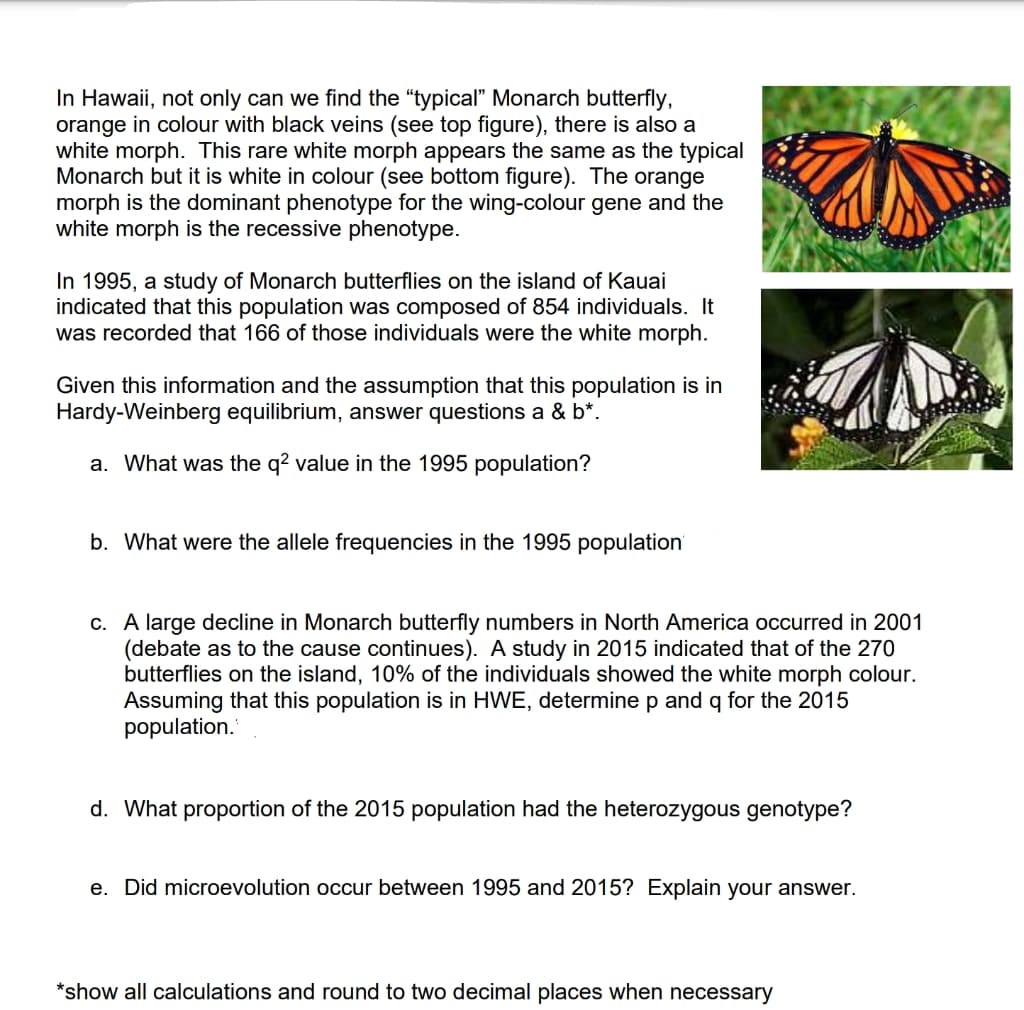In Hawaii, not only can we find the "typical" Monarch butterfly, orange in colour with black veins (see top figure), there is also a white morph. This rare white morph appears the same as the typical Monarch but it is white in colour (see bottom figure). The orange morph is the dominant phenotype for the wing-colour gene and the white morph is the recessive phenotype. In 1995, a study of Monarch butterflies on the island of Kauai indicated that this population was composed of 854 individuals. It was recorded that 166 of those individuals were the white morph. Given this information and the assumption that this population is in Hardy-Weinberg equilibrium, answer questions a & b*. a. What was the q? value in the 1995 population? b. What were the allele frequencies in the 1995 population c. A large decline in Monarch butterfly numbers in North America occurred in 2001 (debate as to the cause continues). A study in 2015 indicated that of the 270 butterflies on the island, 10% of the individuals showed the white morph colour. Assuming that this population is in HWE, determine p and q for the 2015 population. d. What proportion of the 2015 population had the heterozygous genotype? e. Did microevolution occur between 1995 and 2015? Explain your answer.
In Hawaii, not only can we find the "typical" Monarch butterfly, orange in colour with black veins (see top figure), there is also a white morph. This rare white morph appears the same as the typical Monarch but it is white in colour (see bottom figure). The orange morph is the dominant phenotype for the wing-colour gene and the white morph is the recessive phenotype. In 1995, a study of Monarch butterflies on the island of Kauai indicated that this population was composed of 854 individuals. It was recorded that 166 of those individuals were the white morph. Given this information and the assumption that this population is in Hardy-Weinberg equilibrium, answer questions a & b*. a. What was the q? value in the 1995 population? b. What were the allele frequencies in the 1995 population c. A large decline in Monarch butterfly numbers in North America occurred in 2001 (debate as to the cause continues). A study in 2015 indicated that of the 270 butterflies on the island, 10% of the individuals showed the white morph colour. Assuming that this population is in HWE, determine p and q for the 2015 population. d. What proportion of the 2015 population had the heterozygous genotype? e. Did microevolution occur between 1995 and 2015? Explain your answer.
Human Anatomy & Physiology (11th Edition)
11th Edition
ISBN:9780134580999
Author:Elaine N. Marieb, Katja N. Hoehn
Publisher:Elaine N. Marieb, Katja N. Hoehn
Chapter1: The Human Body: An Orientation
Section: Chapter Questions
Problem 1RQ: The correct sequence of levels forming the structural hierarchy is A. (a) organ, organ system,...
Related questions
Question
100%
Please answer fast

Transcribed Image Text:In Hawaii, not only can we find the "typical" Monarch butterfly,
orange in colour with black veins (see top figure), there is also a
white morph. This rare white morph appears the same as the typical
Monarch but it is white in colour (see bottom figure). The orange
morph is the dominant phenotype for the wing-colour gene and the
white morph is the recessive phenotype.
In 1995, a study of Monarch butterflies on the island of Kauai
indicated that this population was composed of 854 individuals. It
was recorded that 166 of those individuals were the white morph.
Given this information and the assumption that this population is in
Hardy-Weinberg equilibrium, answer questions a & b*.
a. What was the q? value in the 1995 population?
b. What were the allele frequencies in the 1995 population
c. A large decline in Monarch butterfly numbers in North America occurred in 2001
(debate as to the cause continues). A study in 2015 indicated that of the 270
butterflies on the island, 10% of the individuals showed the white morph colour.
Assuming that this population is in HWE, determine p and q for the 2015
population.
d. What proportion of the 2015 population had the heterozygous genotype?
e. Did microevolution occur between 1995 and 2015? Explain your answer.
*show all calculations and round to two decimal places when necessary
Expert Solution
This question has been solved!
Explore an expertly crafted, step-by-step solution for a thorough understanding of key concepts.
This is a popular solution!
Trending now
This is a popular solution!
Step by step
Solved in 3 steps

Knowledge Booster
Learn more about
Need a deep-dive on the concept behind this application? Look no further. Learn more about this topic, biology and related others by exploring similar questions and additional content below.Recommended textbooks for you

Human Anatomy & Physiology (11th Edition)
Biology
ISBN:
9780134580999
Author:
Elaine N. Marieb, Katja N. Hoehn
Publisher:
PEARSON

Biology 2e
Biology
ISBN:
9781947172517
Author:
Matthew Douglas, Jung Choi, Mary Ann Clark
Publisher:
OpenStax

Anatomy & Physiology
Biology
ISBN:
9781259398629
Author:
McKinley, Michael P., O'loughlin, Valerie Dean, Bidle, Theresa Stouter
Publisher:
Mcgraw Hill Education,

Human Anatomy & Physiology (11th Edition)
Biology
ISBN:
9780134580999
Author:
Elaine N. Marieb, Katja N. Hoehn
Publisher:
PEARSON

Biology 2e
Biology
ISBN:
9781947172517
Author:
Matthew Douglas, Jung Choi, Mary Ann Clark
Publisher:
OpenStax

Anatomy & Physiology
Biology
ISBN:
9781259398629
Author:
McKinley, Michael P., O'loughlin, Valerie Dean, Bidle, Theresa Stouter
Publisher:
Mcgraw Hill Education,

Molecular Biology of the Cell (Sixth Edition)
Biology
ISBN:
9780815344322
Author:
Bruce Alberts, Alexander D. Johnson, Julian Lewis, David Morgan, Martin Raff, Keith Roberts, Peter Walter
Publisher:
W. W. Norton & Company

Laboratory Manual For Human Anatomy & Physiology
Biology
ISBN:
9781260159363
Author:
Martin, Terry R., Prentice-craver, Cynthia
Publisher:
McGraw-Hill Publishing Co.

Inquiry Into Life (16th Edition)
Biology
ISBN:
9781260231700
Author:
Sylvia S. Mader, Michael Windelspecht
Publisher:
McGraw Hill Education